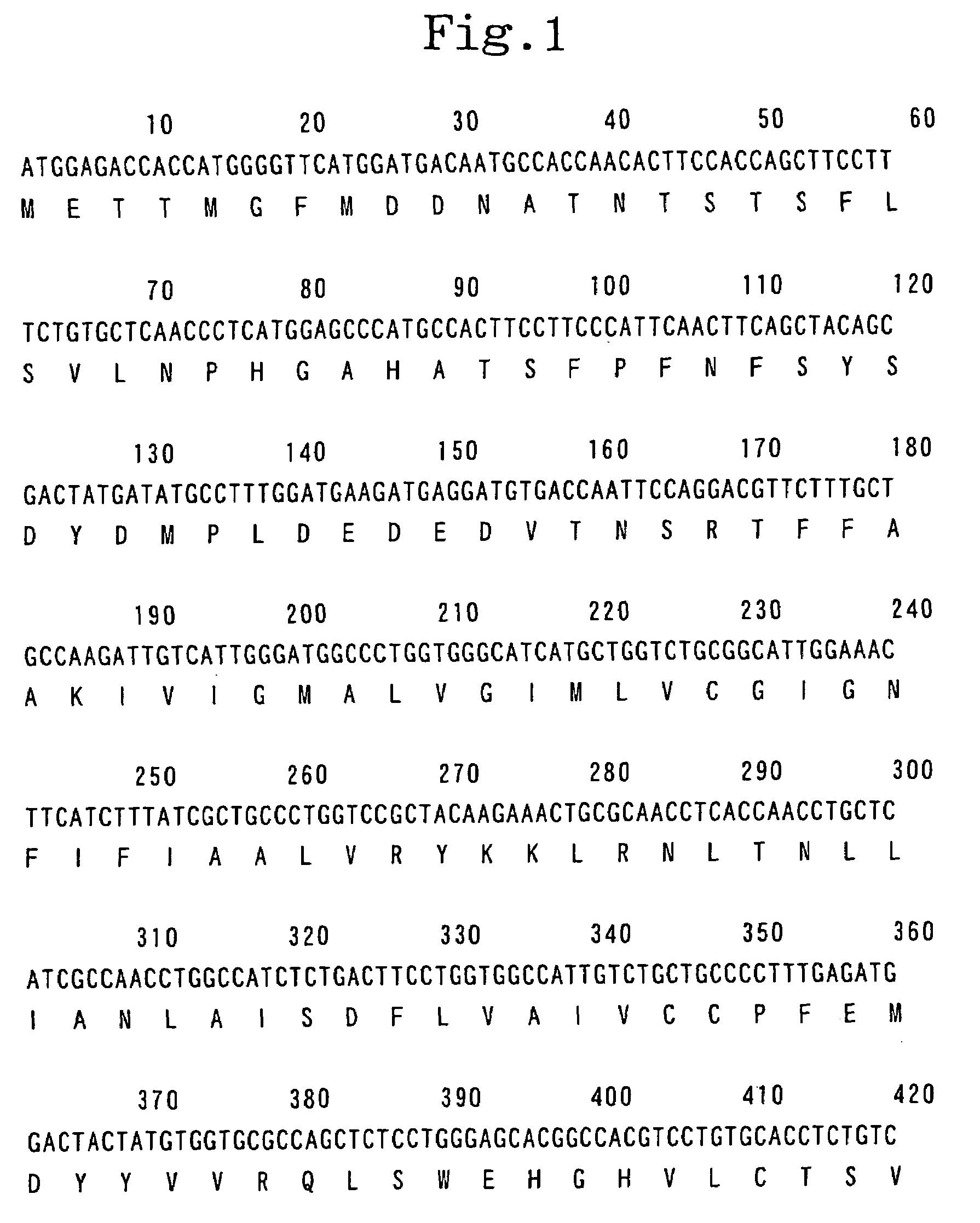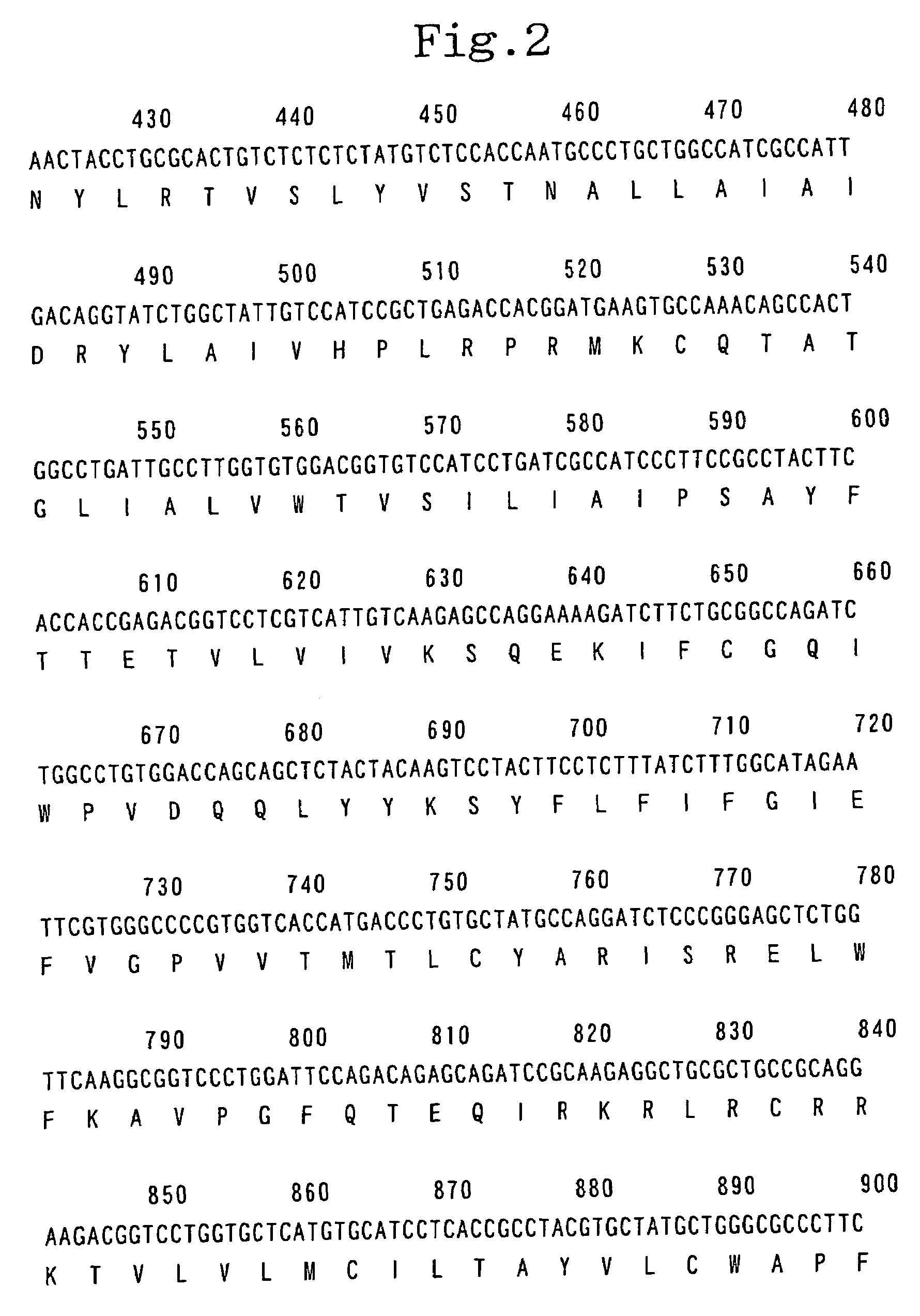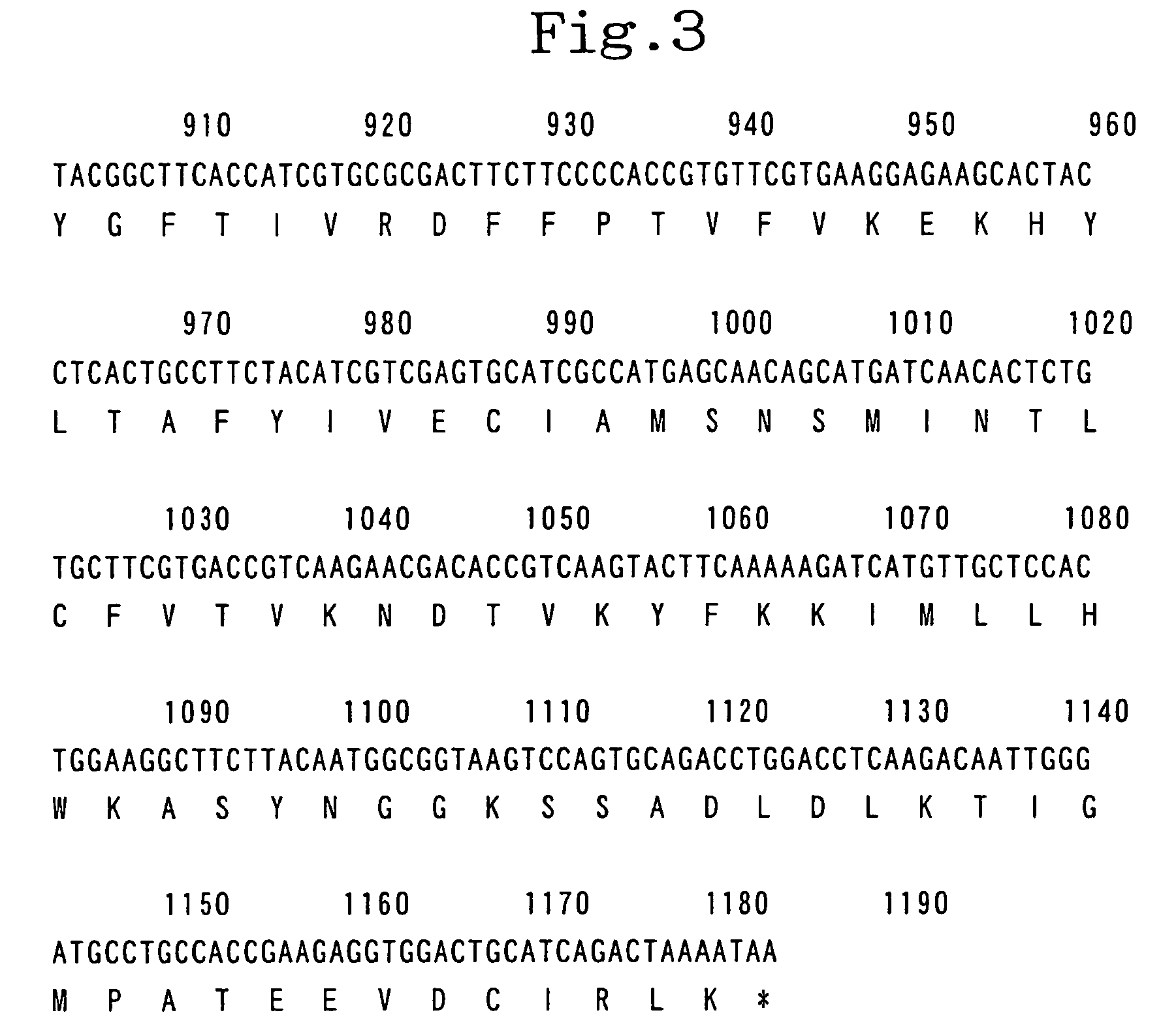Physiologically active peptide and use thereof
a peptide and physiological activity technology, applied in the field of physiologically active peptides, can solve the problems of few examples to actually identify ligands to orphan g protein-coupled receptors, receptors to physiologically active peptides hitherto unknown, and poorly understood if similar methods are used to unravel receptors
- Summary
- Abstract
- Description
- Claims
- Application Information
AI Technical Summary
Benefits of technology
Problems solved by technology
Method used
Image
Examples
example 1
Cloning of cDNA Encoding the G Protein-coupled Receptor Protein ZAQ and Determination of the Base Sequence
[0492]Using human pituitary cDNA (CLONTECH Laboratories, Inc.) as a template and two primers, namely, primer 1 (5′-GTC GAC ATG GAG ACC ACC ATG GGG TTC ATG G- 3′; SEQ ID NO:4) and primer 2 (5′-ACT AGT TTA TTT TAG TCT GAT GCA GTC CAC CTC TTC -3′; SEQ ID NO:5), PCR was carried out. The reaction solution in the above reaction was composed of 1 / 10 volume of the cDNA described above, 1 / 50 volume of Advantage 2 Polymerase Mix (CLONTECH Laboratories, Inc.), 0.2 μM of primer 1, 0.2 μM of primer 2, 200 μM dNTPs and a buffer supplied with the enzyme to make the final volume 25 μl. In the PCR, after the reaction solution was heated at 94° C. for 2 minute, a cycle set at 94° C. for 20 seconds followed by 72° C. for 100 seconds was repeated 3 times, a cycle set at 94° C. for 20 seconds and at 68° C. for 100 seconds was repeated 3 times, a cycle set at 94° C. for 20 seconds; at 64° C. for 20 s...
example 2
Analysis of Expression Distribution of ZAQ by Taqman PCR
[0493]Primers and a probe to be used in Taqman PCR were surveyed using Primer Express Ver.1.0 (PE Biosystems Japan), and primer 3 (5′-TCATGTTGCTCCACTGGAAGG-3′ (SEQ ID (NO: 6)), primer 4 (5′-CCAATTGTCTTGAGGTCCAGG-3′(SEQ ID NO: 7)) and ZAQ probe (5′-TTCTTACAATGGCGGTAAGTCCAGTGCAG-3′ (SEQ ID NO: 8)) were selected. FAM (6-carboxyfluorescein) was added as a reporter dye for the probe.
[0494]The PCR fragment, which was amplified using pAK-ZAQC as a template, and primer ZAQC Sal (5′-GTCGACATGGAGACCACCATGGGGTTCATGG -3′ (SEQ ID NO: 9)) and primer ZAQC Spe (5′-ACTAGTTTATTTTAGTCTGATGCAGTCCACCTCTTC-3′ (SEQ ID NO: 10)), was purified with CHROMA SPIN200 (CLONTECH Laboratories, Inc. (CA,USA)), and then adjusted to have a concentration of 100–106 copies / μl for usage as a standard DNA. Human Multiple Tissue cDNA Panel I and Panel II (CLONTECH Laboratories', Inc.) were used as the cDNA source for each tissue. To the primers, probe and template, Ta...
example 3
Isolation of ZAQ-activating Peptide
(3–1) Preparation of Milk Extract Solution
[0497]Using commercially available milk, which was pasteurized at a low temperature, the following procedures were performed to prepare an extract solution. Two litters of milk were centrifuged at 10,000 rpm for 15 minutes at 4° C. with a high-speed centrifuge (CR26H, R10A rotor: Hitachi, Ltd.). The obtained supernatant was filtered through gauze to remove lipids. Acetic acid was added to the supernatant to adjust the concentration at final concentration of IM, and the mixture was agitated for 30 minutes at 4° C. Then, the mixture was centrifuged at 10,000 rpm for 15 minutes with a high-speed centrifuge (CR26H R10A rotor: Hitachi System Engineering Co., Ltd.). The obtained supernatant was filtered to remove insoluble matters. While agitating, acetone was added thereto as twice as much volume of the supernatant. Agitation was continued at 4° C. for 3 hours. Next, the mixture was centrifuged at 10,000 rpm for...
PUM
| Property | Measurement | Unit |
|---|---|---|
| temperature | aaaaa | aaaaa |
| temperature | aaaaa | aaaaa |
| temperature | aaaaa | aaaaa |
Abstract
Description
Claims
Application Information
 Login to View More
Login to View More - R&D
- Intellectual Property
- Life Sciences
- Materials
- Tech Scout
- Unparalleled Data Quality
- Higher Quality Content
- 60% Fewer Hallucinations
Browse by: Latest US Patents, China's latest patents, Technical Efficacy Thesaurus, Application Domain, Technology Topic, Popular Technical Reports.
© 2025 PatSnap. All rights reserved.Legal|Privacy policy|Modern Slavery Act Transparency Statement|Sitemap|About US| Contact US: help@patsnap.com



